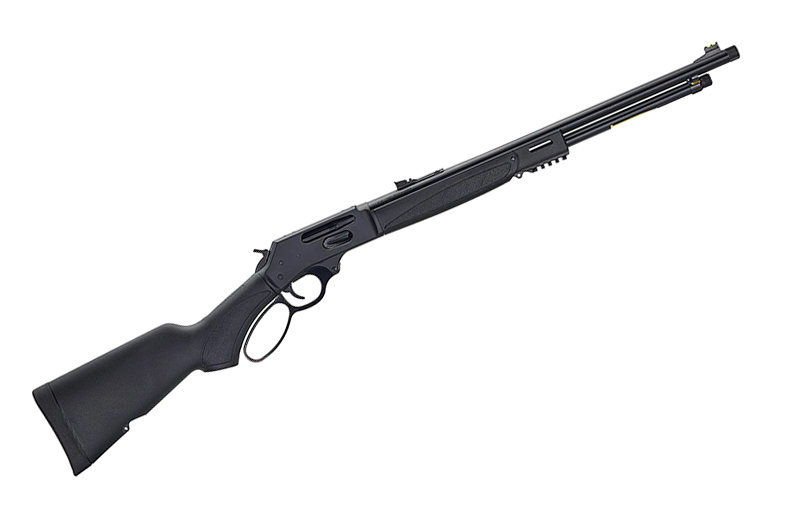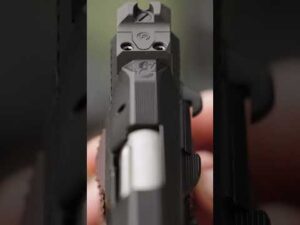Lever-action rifles, among the oldest repeating designs in the United States, have remained a reliable and nostalgic choice for over a century and a quarter. While the quality of most guns may not be as high-quality as in the late 19th-century, CNC machining, and other modern advances have made them more consistent. The Henry Model X, in.360 Buckhammer. We still have many of those classic rifles from the late-19th and early-20th centuries. Many of their cartridges are still popular today. There are many old rifle cartridges still in use today. The.45-70 Government dates back to 1873. The.38-55 WCF dates back to 1876. And the.30-30 Winchester was introduced in 1895. If you hunt in a region where any rifle cartridge will do, then the world is at your fingertips. But if you want to use a centerfire for big game in certain Midwestern States, you’ll have to adhere to a specific set of game laws. Some states limit the length of the case or specify a minimum diameter for bullets. To comply with the rules and offer an advantage over the bigger, and often slower, straight-wall cases–like the .45-70 Government, .444 Marlin, .450 Bushmaster and .38-55 Winchester–ammunition companies have released some new designs. Winchester launched the.350 Legend which can be used in a bolt gun, AR platform or both. Remington responded with their.360 Buckhammer for 2023. The.360 Buckhammer was based on the.30-30 Winchester (derived from the older.3855 Winchester), with the case walls re-aligned. It is, if we may, a twist of the idea of combining a.30-30 and a.35 Remington. It has the same rim diameter of.506 inches as its sire but a case size of 1.80 inch, which is shorter than the.35 Remington or.30-30 Winchester. The maximum cartridge length is 2.5 inches. This is also a little bit shorter than both the.35 Remington and.30-30 Winchester. A straight-walled case that adheres to certain game laws in Midwest, the Buckhammer.360 meets certain criteria for hunters in need. Photo: Massaro Media Group. The.360 Buckhammer comes in 180-grain and 200-grain loads with projectiles measuring 0.358 inches. It also features the tried-and-true Core-Lokt round nose bullet. A cup-and core bullet with a crimping groove allows for a good roll-crimp on the case mouth, as well as locking the core and jacket. The.360 Buckhammer is a good deer projectile, especially at moderate speeds. With the 180-grain load traveling at 2,400 fps while the 200-grain loads move at 2,200 fps the.360 Buckhammer has a significant velocity advantage over the standard.35 Remington which typically moves the same pair of bullets at 2,120 and 2,080 respectively. These Core-Lokt Bullets are round-nosed and do not have the best ballistic coefficients, but their nose profile makes them safe to use in the tubular magazines of many lever-action guns. Photo: Massaro Media Group. Using a 1:12 turn, the.360 Buckhammer can offer handloaders the ability to use heavier bullets. However, velocities are sure to drop. The.360 Buckhammer will be a great choice for those who like to use a lever-action to hunt whitetails and bears in thicker woods. Any new cartridge is exciting, as long as you can fire it. The.360 Buckhammer is not one of those cartridges that are introduced at SHOT Show and then disappear from the market for a long time. Henry Rifles has worked with Remington to produce four different models chambered for Buckhammer. These include the Lever Steel, Side Gate Lever action, Single Shot Steel, and the Model X, which I was able to review. Photo: Massaro Media Group. When I reach for a lever gun, I expect it to be blued steel, walnut, or birch. I would even be calm if the stock was made of stainless steel or laminated wood, like on a Browning BLR. But a synthetic stock, you ask? Before I held the Henry Model X in my hands, I would have called it blasphemy. But after I did, I changed my mind. The Model X may cause any lever purists to raise an eyebrow, but it is a serious hunting rifle, with many useful and well-thought out features. With a receiver that is reminiscent of the Marlin 336 and a side eject feature, the Henry Model X has the advantage of a solid top receiver and side eject so an optic can mounted low to bore. The Model X does not have a safety or a half-cock. Instead, it uses a transfer lever located on the face of the hammer. The Henry Model X, while it may seem odd to see a polymer-stocked gun, is a solid design that performs well. Using my Lyman Digital Trigger Scale I measured the Model X’s trigger break at 3.9 lbs, 9 ounces. There was almost no creep, and only a little overtravel. This was a nice lever gun. Henry has provided the Model X a large, comfortable lever loop. The muzzle can be threaded to accept either a suppressor or brake, and the brass-sleeved magazine gives the shooter a wide range of options. Photo: Massaro Media Group. The 21 3/8-inch barrel has a fiber-optic front and rear sight that are fully adjustable. It is threaded with a cap to allow for the installation of a suppressor or brake. The tubular magazine can be accessed via the side gate lever located on the right side, just below the ejection hole. At the muzzle, the magazine is accessed via a cutout at the bottom of the magazine that is capped with a brass liner tube. The tube magazine holds five rounds. Once I got over my initial doubts, the stock proved to be both useful and comfortable. It’s a 2-piece design with a curved grip and textured patches at the pistol grip and forend. This gives a good grip even when wet. The buttstock features a solid rubber pad for recoil, which I found to be a bit on the hard side. To my delight, it has a 14-inch pull length. The solid rubber buttplate on the Henry Model X is a great addition to the rifle. Photo: Massaro Media Group.Instead sling-swivels, which are normally screwed in the stock, Henry opted to mould them into the wood, so that there is nothing to come off, rust, or squeak. The Model X’s butt is symmetrical and has no cheekpiece. This means that left-handed shooters can use it just as easily as right-handed ones. The Henry Model X comes with both a Picatinny and M-Lok option at the forend. This allows for a wide range of attachments. Photo: Massaro Media Group.To get the Model X ready for the range, I screwed a Leupold VX-3i 3.5-10x40mm Scope–long proven to be a rugged and reliable choice for deer hunting at first and last light –into Talley detachable ring on the top of the X receiver. I chose the Talleys because they allow me to quickly access the iron sights. This setup is perfect for those who want to use their Model X rifle in thick terrain and still be able to confidently reattach the scope to the point of aim. The Henry rifle felt very little recoil even when shooting from the bench. The trigger broke well, allowing for the crosshair to remain on target, and the minimal muzzle-jump helped me re-acquire the target quickly. Both the 180-grain and 200-grain loads delivered sub-MOA precision–much more than I expected from a lever-gun–with the 200 grain load printing slightly better. The best three-shot group hovered around 1/2-MOA, the worst under an inch and the average was just above 3/4-MOA. The.360 Buckhammer delivered sub-MOA accuracy using both 180-grain and 200-grain ammunition. Photo: Massaro Media Group.At least, the combination between Henry Model X ammo and Remington.360 buckshammer ammunition is very inspiring. While it may not be as flat-shooting as a 6.8 Western or.308 Winchester, it is a great woods gun with slightly faster velocities than the comparable.35 Remington. The 180-grain load averaged 2,387 fps, and the 200 grain load 2,208. During the bench session, every cartridge fed and was extracted without issue. In fact, the Henry out-of-the box was much smoother than most of the modern Winchesters or Marlins that I’ve used. In spite of my initial apprehensions–solely based on my visual impression–I really enjoyed taking the Henry to the bench and wouldn’t hesitate to spend a season here in my native New York with this combination.Many will repeat the fact that the century-plus-old .35 Remington gives a similar performance, but that’s not entirely reason enough to discount the Buckhammer. Others will say the venerable,.30-30 Winchester cartridge is so widely available and readily available that it doesn’t make sense to switch. Or, if you want to hunt with a larger cartridge than.30, then the next logical step would be the original straight wall lever cartridge, the.3855 Winchester. The.360 Buckhammer is a higher-pressure version of the classic formula. The Henry Model X flat-top receiver matched perfectly with a Leupold VX-3i 3.5-10x40mm Scope, set in Talley removable rings. Photo: Massaro Media Group. Taking niche game laws out of the equation, I think the 360 Buckhammer cartridge is a great choice for hunters who stay within 150 or 175 yard ranges in pursuit of black bears and whitetail deer. It’s easy to carry, comes in four different Henry rifle models (proudly manufactured in the USA), and is more powerful than the.30-30 Remington or.35 Remington. I hope the.360 Buckhammer will get the “modern spitzer treatment” that Hornady gave to so many classic rimmed rounds and the same bonded core treatment Federal gave to their HammerDown line. More rifles are likely to be released by other companies. To summarize, I like the Buckhammer. Is this going to be the rifle that I use every day? But I doubt it, as my heart is with bolt-action guns. Raise Your Lever Gun IQ: Improve your shooting precision with our 62-MOA Targets. They are perfect for handguns and rifles. Crafted in collaboration with Storm Tactical for accuracy and versatility.Subscribe to the Gun Digest email newsletter and get your downloadable target pack sent straight to your inbox. Stay up to date with the latest information on firearms.

Hornady hosts the 3-gun fit” Zombies in Heartland 2025″ in the Heartland 2025.
June 4th, 2025 Nearly 400 people showed up in Grand Island, Nebraska on May 30 through June 1st, 2025 to take on the “undead” during the annual Undead in the
















